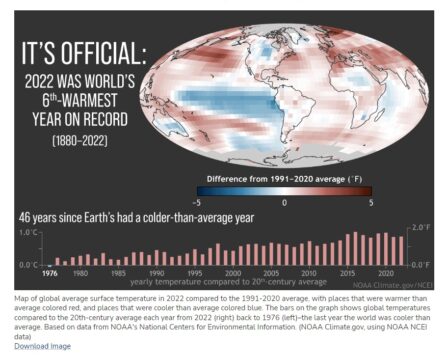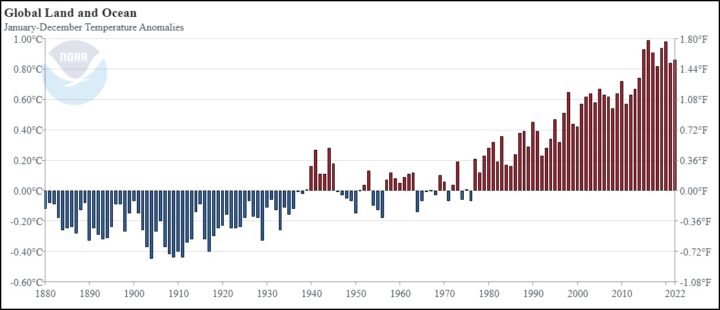SciCheck Digest
The warming trend in global temperature continued in 2022, which was the sixth-warmest year on record, according to a recent report from the National Oceanic and Atmospheric Administration. But a viral tweet — using just a small segment of a NOAA graph — wrongly claimed the agency had announced a “global cooling” trend.
Full Story
The sixth-warmest year on record was in 2022, the National Oceanic and Atmospheric Administration reported on Jan. 12.

NOAA had released highlights from its most recent annual global climate report showing the planet’s average land and ocean surface temperature was 1.55 degrees Fahrenheit higher in 2022 than the 20th century average, which was 57 degrees F. This rise in temperature is part of an upward trend going back decades.
But Steve Milloy, who is on the board of a think tank that publishes content denying the existence of climate change, claimed “NOAA makes it official” that the “last 8 years” of temperature data show a “global cooling” trend.
That’s wrong. NOAA actually said the opposite.
“The planet continued its warming trend in 2022,” the agency’s press release said, “with last year ranking as the sixth-warmest year on record since 1880.”
But Milloy twisted the agency’s finding by copying and sharing a small portion of one of the graphs included in the release.

In a Twitter post that received more than 13 million views, Milloy shared an image showing the tail end of a much larger bar graph and misinterpreting what the larger graph showed. He included just the last eight years of the bar graph that, in its entirety, showed how global temperatures compared to the 20th century average for the last 47 years (shown at right).
In the full report, NOAA included another graph showing the same data, but going back even further — 143 years, to 1880, when records began. That graph shows an even starker change.
“The 10 warmest years in the 143-year record have all occurred since 2010, with the last nine years (2014–2022) ranking as the nine warmest years on record,” the report says.
But, as we said, Milloy claimed that this data from NOAA showed that “CO2 warming is a hoax” by showing data for only the last eight years.
Understanding Fluctuations in the Climate
“I can’t believe this old canard is back,” Gabriel Vecchi, professor of geosciences at Princeton University and director of the High Meadows Environmental Institute, told FactCheck.org in an email.
“Multi-year periods of flat (or slightly negative) temperature changes are to be expected in a warming world,” he said, citing a 2016 paper that explained a warming slowdown in the early 2000s.
Vecchi highlighted some of the findings from the full NOAA report, including:
- Every year since 2015 has been warmer than any year from 1880 to 2014.
- Every year so far in the 21st century has been warmer than every year between 1880 and 2000 (except for 1998, which included a strong El Niño — more on that later).
- As the graph showed, every year since 1977 has been warmer than the average for the 20th century.

“The planet has warmed and is warm,” he said, noting that the Intergovernmental Panel on Climate Change has repeatedly found that the peer-reviewed literature on climate science indicates that “one cannot explain the warming over the past century in the absence of human-induced increases in atmospheric greenhouse gases (CO2, methane, etc).”
Showing only the last eight years of temperature change is, Vecchi said, “at best, irrelevant for assessing the reality of global warming.”
But, he said, “I think that the Tweet actually obfuscates and misleads.” Showing only the last eight years to suggest that warming has slowed or reversed doesn’t account for how the climate system works, he explained. For example, it takes out of context the impact of phenomena like El Niño and La Niña, climate patterns that develop in the Pacific Ocean roughly every two to seven years and affect global weather.

“It is well-understood that fluctuations in the climate system, like El Niño and La Niña events can cause temporary periods of surface warming and cooling (respectively), due to the redistribution of warm ocean waters in the tropics and their impacts [on] the atmosphere and clouds,” Vecchi said, citing a 2009 paper that removed the effects of events such as El Niño and volcanic eruptions from the temperature record and found “a nearly monotonic global warming pattern since ∼1950.”
So, Vecchi said, “we expect that as the planet warms in response to increasing greenhouse gases, there should be multi-year periods in which the warming appears to accelerate and others in which [it] appears to slow down – and if one picks precisely the right years, one can find periods where there are temporary nominally negative trends.”
That appears to be the case for the eight years that Milloy selected. An El Niño in 2015 and 2016 resulted in surface warming, followed by La Niña in 2020 through 2022, which led to surface cooling.
“The role of the Pacific in driving multidecadal swings in global temperatures is understood well now,” Vecchi said. “If a big El Niño precedes a sequence of La Niña events, then one should expect to see a reduced (and potentially absent) rate of global warming over that period.”
So, presenting only the last eight years of climate data out of the context of the longer-term trend — and without explaining that timespan included, first, a warming period due to El Niño and then a cooling period due to La Niña — is deceptive.
Correction, Jan. 27: Every year so far in the 21st century has been warmer than every year between 1880 and 2000, except for 1998. We had omitted the exception in the original story.
Editor’s note: FactCheck.org is one of several organizations working with Meta to debunk misinformation shared on social media. Our previous stories can be found here. Meta has no control over our editorial content.
Sources
National Oceanic and Atmospheric Administration. Press release. “2022 was world’s 6th-warmest year on record.” 12 Jan 2023.
National Oceanic and Atmospheric Administration. “Annual 2022 Global Climate Report.” Jan 2023.
Vecchi, Gabriel. Professor of geosciences, Princeton University. Email response to FactCheck.org. 24 Jan 2023.
Fyfe, John, et al. “Making sense of the early-2000s warming slowdown.” Nature Climate Change. 24 Feb 2016.
Intergovernmental Panel on Climate Change. Reports. Accessed 25 Jan 2023.
National Ocean Service. “What are El Niño and La Niña?” Updated 20 Jan 2023.
Thompson, David W. J., et al. “Identifying Signatures of Natural Climate Variability in Time Series of Global-Mean Surface Temperature: Methodology and Insights.” Journal of Climate. 15 Nov 2009.
National Oceanic and Atmospheric Administration. “2015 State of the Climate: El Niño came, saw, and conquered.” 2 Aug 2016.
Jones, Nicola. “Rare ‘triple’ La Niña climate event looks likely — what does the future hold?” Nature. 23 Jun 2022.